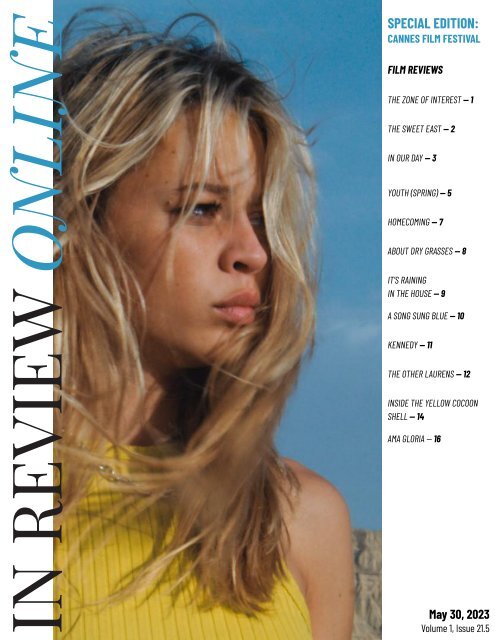You also want an ePaper? Increase the reach of your titles
YUMPU automatically turns print PDFs into web optimized ePapers that Google loves.
IN REVIEW ONLINE<br />
SPECIAL EDITION:<br />
CANNES FILM FESTIVAL<br />
FILM REVIEWS<br />
THE ZONE OF INTEREST <strong>—</strong> 1<br />
THE SWEET EAST <strong>—</strong> 2<br />
IN OUR DAY <strong>—</strong> 3<br />
YOUTH (SPRING) <strong>—</strong> 5<br />
HOMECOMING <strong>—</strong> 7<br />
ABOUT DRY GRASSES <strong>—</strong> 8<br />
IT’S RAINING<br />
IN THE HOUSE <strong>—</strong> 9<br />
A SONG SUNG BLUE <strong>—</strong> 10<br />
KENNEDY <strong>—</strong> 11<br />
THE OTHER LAURENS <strong>—</strong> 12<br />
INSIDE THE YELLOW COCOON<br />
SHELL <strong>—</strong> 14<br />
AMA GLORIA <strong>—</strong> 16<br />
May 30, 2023<br />
<strong>Volume</strong> 1, <strong>Issue</strong> <strong>21.5</strong>
CANNES FILM FESTIVAL<br />
THE ZONE OF INTEREST<br />
Jonathan Glazer<br />
The issue at the heart of Jonathan Glazer’s The Zone of Interest is<br />
one of the oldest in the cinema: how does one represent the<br />
unrepresentable? Loosely adapted from Martin Amis’ novel of the<br />
same name, and set in 1942, the film is centered around the Höss<br />
household: a German family who live in a large, two-story house<br />
with tasteful, minimal decor, complete with a swimming pool, a<br />
greenhouse, and a flourishing garden. The house also happens to<br />
be located directly across from the Auschwitz death camp. The<br />
film’s conceptual hook, if it can be called that, is that the horrors<br />
of the Holocaust will be deliberately kept off-screen and only<br />
indirectly represented <strong>—</strong> no violence will be visually depicted<br />
within the frame. Instead, we will mainly observe as Rudolf Höss<br />
(Christian Friedel), a German SS officer and the camp’s<br />
commandant, goes about his job, while his wife, Hedwig (Sandra<br />
Hüller), keeps house and tends to the children. A visit from<br />
Hedwig’s mother, who marvels at how well her daughter has done<br />
for herself, drives the film’s conceit home: the slaughter of the<br />
Jews by the Nazi regime will be refracted through the Höss<br />
family’s blinkered, bourgeois privilege.<br />
Though somewhat specious in broad outline, this conceit is not,<br />
in itself, cause for suspicion. Of more concern, ultimately, is the<br />
fact that Glazer has a rather limited, thuddingly literal<br />
understanding of representation. In each and every one of his<br />
meticulously composed frames, he does little more than<br />
portentously accentuate the out-of-field, drawing attention to<br />
what lies just beyond the visible image. Thus, we will only ever<br />
see the smoke of the trains that periodically arrive at Auschwitz.<br />
A shot of Friedel in the camp will be angled upwards in such a<br />
way that we see only the blue sky above him, even as we hear<br />
screams and shooting all around. A child will play in his room,<br />
stop momentarily to look out a window when he hears a<br />
commotion outside, and then resume his game as before. With<br />
Under the Skin (2013), Glazer delivered a panoply of arresting,<br />
Kubrickian images that synced well with the film’s literally alien<br />
subject. In Zone of Interest, he does something similar, employing<br />
a range of visual effects that keep the Höss family at a chilly<br />
remove, as well as irruptions of imagery meant to signal stilldeeper,<br />
more unrepresentable layers of disquiet. But as there’s<br />
no natural place for free-floating abstraction à la Under the Skin,<br />
Glazer’s taste for portent here becomes wedded to a fairly<br />
simple, and indeed simplistic, treatment of off-screen space.<br />
1
FESTIVAL COVERAGE<br />
The Zone of Interest modulates its approach in precisely one<br />
sequence, where Glazer ties an incipient narrative development<br />
<strong>—</strong> Rudolf informing Hedwig that he has been transferred and that<br />
they may have to move <strong>—</strong> to his usual formal assertiveness in a<br />
manner reminiscent of Alan Clarke. It’s the one scene where<br />
Glazer does something other than keep the Höss family at an<br />
alienating remove. Winner of this year’s Grand Prix, The Zone of<br />
Interest has already been <strong>—</strong> and will continue to be <strong>—</strong> praised for<br />
its unfailing control and precision; and such statements do stand<br />
to reason. But if Glazer does not step a foot wrong, it’s because<br />
he does not risk much to begin with. The film is, to be sure,<br />
formally and conceptually coherent, even airtight. But coherence<br />
is not the same thing as audacity, and with the arguable<br />
exception of the film’s final moments, which briefly venture into<br />
territory that recalls Sergei Loznitsa’s Austerlitz (2016), Glazer has<br />
made a film that, very much despite its subject, plays it safe. <strong>—</strong><br />
LAWRENCE GARCIA<br />
THE SWEET EAST<br />
Sean Price Williams<br />
An easy bit of advice to give to any filmmaker who tries, whether<br />
with journalistic integrity or well-meaning folksy soapboxery, to<br />
make a film about our contemporary political moment: don’t. It’s<br />
easy enough advice to follow, and it frees the advice-ee from the<br />
label of cringe that can only come from the same culture that<br />
had initially welcomed, begged, for content of the now. Already,<br />
the subcultures of yesteryear have metastasized into something<br />
stranger and even more ephemeral in this, and the mere public<br />
naming of any new political group is enough to destroy it as if it<br />
were borne of a curse.<br />
The Sweet East, the debut feature of veteran cinematographer<br />
Sean Price Williams, does not follow this advice. Thankfully, there<br />
is no soapbox in sight. Instead, the characters representing our<br />
various political moments mold themselves to more ancient<br />
sources, like Shakespearean villeins or the many ghosts of<br />
history. They form an American landscape void of values and full<br />
of snake oil, traversed by normies whose curiosity could get<br />
them killed.<br />
The normie in question here is Lillian (Talia Ryder), whose<br />
anodyne class trip to Washington, D. C. immediately halts thanks<br />
to a Pizzagate conspirator’s viable threats. Lillian is whisked<br />
from her classmates by strangers modeled after antifa, who, like<br />
all the groups here, promise that they uniquely have Lillian’s best<br />
interests in mind until their values give way to more petty<br />
concerns. Key among these users and abusers of Lillian is Simon<br />
2
CANNES FILM FESTIVAL 2023<br />
Rex’s fascist Edgar Allan Poe scholar, Lawrence, whose true<br />
danger lies beneath his veneer of cold, “trad” academia, even<br />
once barking at Lillian that one cannot just make certain claims<br />
without good scholarship. He brings her to New York City, where<br />
Lillian falls in with a filmmaking duo (Jeremy O. Harris and Ayo<br />
Edebiri) and the film’s lead actor (Jacob Elordi). The process<br />
repeats throughout the east coast as a road movie, an Odyssean<br />
journey, a riff on Alice in Wonderland, or perhaps an anti-Pilgrim’s<br />
Progress where confusion replaces spiritual development.<br />
Frontloading with tons of pop culture and cinephile miscellany<br />
and esoterica, the film could easily have lost itself in games of<br />
“spot the D. W. Griffith reference” here and “catch Nick Cave’s<br />
kid” there. Thankfully, each of these references take a backseat<br />
to the constantly nerve-wracking vibes each political group gives<br />
off. The promise of violence finally erupts in a shootout that<br />
plays as dramatic yet opts for visual gags befitting a Scary<br />
Movie sequel <strong>—</strong> a compliment. That’s the tone of Lillian’s (likely<br />
named for Griffith favorite Lillian Gish) journey: that these<br />
American weirdos are worth taking seriously, but not too<br />
seriously.<br />
Williams, as DP, opts for his usual ‘70s verité style of<br />
camerawork, switching from classical compositions to<br />
shallow-focus zooms during dramatic moments. There’s a<br />
particular sort of Kodak color grade that washes over the entire<br />
picture that’s reminiscent of high-grade stock footage from a<br />
bygone era, which, though never distracting, does hint that this<br />
may already be a world that’s long passed. The budget here isn’t<br />
quite big enough for the team to acquire the rights to a<br />
punk-ethos soundtrack, but Paul Grimstad’s score (complete with<br />
what sounds like a mouth harp during a rather appropriate<br />
scene) sets a mood of cascading tension as Lillian cleverly<br />
navigates her way out of danger.<br />
Though rapscallion film critic Nick Pinkerton, the screenwriter of<br />
The Sweet East, pens a rather cynical screed against the limited<br />
factional options of 21st-century American culture, there are<br />
nuances and caveats aplenty. Not all of his middle fingers carry<br />
the same stature: the Nazis here are clearly the worst and most<br />
violent compared to, say, the filmmakers or the raving Islamists,<br />
even as Rex’s Lawrence turns up the charm by admitting to<br />
“being afflicted with enough vainglory already,” defending the<br />
artistic devices in D. W. Griffith’s The Avenging Conscience<br />
(though perhaps loving the unlovable parts of Griffith’s past), and<br />
chiding Lillian for being “grossly reductive,” unbefitting of<br />
“scholarship” for her recollecting his labeling someone a Jew.<br />
That said, this is still not a film that would pedantically lay out<br />
the gradations of its characters’ morality, nor would it make<br />
make grandiose political harrumphs, not even “fuck it all.” The<br />
Sweet East treats America as a freak show where you can stop,<br />
move on, join it, love it, or hate it, but you can never go home. <strong>—</strong><br />
ZACH LEWIS<br />
IN OUR DAY<br />
Hong Sang-soo<br />
Hong Sang-soo’s second film of 2023 <strong>—</strong> and 30 th overall in a<br />
27-year career <strong>—</strong> premieres just a few short months after in<br />
water at Berlinale. That film found Hong investigating the nature<br />
and process of making cinema, both in general and in his own<br />
idiosyncratic manner. It was a bit of an experiment, of course,<br />
being filmed, to varying degrees, out-of-focus <strong>—</strong> and ending on a<br />
note of unsettling ambiguity, as a director walks into the ocean<br />
(on camera, naturally) like James Mason in A Star Is Born. That<br />
ending essentially inverts the one from The Novelist’s Film, a 2021<br />
Hong festival entrant, which concludes with what appears to be<br />
a moment of pure love between a director and his star, Kim<br />
Min-hee (also Hong’s key collaborator for most of the last<br />
decade). Now, In Our Day continues Hong’s meditations on art,<br />
albeit with neither the potentially alienating effects of in water<br />
nor the direct and triumphant beauty of The Novelist’s Film.<br />
Instead, we find Hong in more conventional territory, with a split<br />
narrative about younger people asking older artists for advice,<br />
and not quite getting answers they find helpful.<br />
The first of the film’s narratives stars Kim as an actress who has<br />
returned to Korea after some time abroad and is staying with an<br />
old friend (a designer, or model, perhaps <strong>—</strong> or just someone with<br />
an impressive collection of shoes). After spending some quality<br />
time with the friend’s big fluffy cat named “Us” (later to be the<br />
subject of what is now this reviewer’s single favorite Hong zoom<br />
shot ever), Kim is visited by her younger cousin, who wants to<br />
venture into acting and solicits her for advice. Kim explains that<br />
acting, perhaps paradoxically, is about truth, personal inner truth<br />
<strong>—</strong> tapping into yourself with complete honesty and<br />
3
FESTIVAL COVERAGE<br />
channeling that truth into performance. The cousin says she<br />
understands… but one has their doubts.<br />
The second narrative stars Gi Jubong (Hotel by the River,<br />
Introduction) as a renowned poet. A young film student is making<br />
a film about him, and he laments to her that he can no longer<br />
drink or smoke due to health concerns (much like Hong himself).<br />
They’re visited by a young man who, like Kim’s cousin, wants to<br />
go into acting. He wants the poet’s advice, though it’s not entirely<br />
clear why (we may surmise that it has something to do with the<br />
pretty documentarian, though she doesn’t seem to know who he<br />
is). The young man asks the old one vague questions (what is<br />
love, why make art, what is it all for, etc.) and gets truthful but<br />
perhaps poorly comprehended answers. The scene is<br />
reminiscent of the third film-within-a-film in Hong’s 2010<br />
masterpiece, Oki’s Movie, in which two film students ask their<br />
professor a variety of questions about life and art and take in his<br />
pithy, reasonably profound responses. One of the poet’s answers<br />
is essentially the same as one the professor in that film gave:<br />
when asked why he chose to pursue poetry, the poet explains<br />
that he doesn’t know, and more to the point, that he doesn’t know<br />
why he does anything; in Oki’s Movie, the professor claims “In life.<br />
. . of all the important things I do, there’s none I know the reason<br />
for. I don’t think there is.” This, in turn, echoes Hong’s<br />
recent comments at a New York retrospective of his work, as<br />
reported in The New Yorker: “The most precious thing in life is<br />
always something that is given to me. If I look back on my life,<br />
the most wonderful things were always given to me, free or<br />
unexpectedly. Never in life did I get something wonderful by<br />
trying to get it or with a strong intention.” Instead, as Hong has<br />
done in several films recently, the poet asserts a kind of<br />
existentialism: what is important is living in the moment, in truly<br />
seeing and experiencing what is in front of your face.<br />
So if we combine ideas central to these two stories, we might<br />
have something like Hong and Kim’s theory of art: radical<br />
personal honesty and emotional truth, combined with an<br />
openness to any possible experience of the world and of chance.<br />
These theories are put to the test in the second half of the film.<br />
The beloved cat Us disappears and his owner is distraught,<br />
crying and screaming in anguish. After walking the streets<br />
looking for him, she comes home and collapses in a heap on the<br />
floor, as Kim calmly tries to get her to relax and focus on the<br />
next step of the search. Song Sunmi’s performance, to this point<br />
in tune with Hong’s usual register of relaxed naturalism, becomes<br />
so demonstrative, the performance of her emotion so extreme<br />
(though essentially just lying still), that it pushes the bounds of<br />
believability. Is this the honesty Kim advised? Or is the<br />
4
CANNES FILM FESTIVAL 2023<br />
scene effective despite the overplaying, belying Kim’s theory of<br />
acting? Similarly, the poet is faced with a choice. The young<br />
man’s questioning gives him a strong urge to drink (a point made<br />
by a quite funny intertitle; all the scenes are preceded by such<br />
titles, some of which describe what is to come, some of which<br />
explain inner thoughts that otherwise are too subtly expressed to<br />
be picked up on), and despite the documentarian’s concerns, the<br />
man goes out and gets some soju. Several bottles later, the poet<br />
introduces Rock-Paper-Scissors to the group as a drinking game,<br />
and proceeds to outdrink both kids. Those two eventually leave<br />
together, in a scene that could have come from any number of<br />
earlier Hong films (Oki’s Movie, certainly). But we, the audience <strong>—</strong><br />
and by extension, Hong, who’s much older now than when those<br />
films were made <strong>—</strong> stay with the poet, who sets up on his<br />
balcony, armed with a bottle of Johnnie Walker Black, a pack of<br />
cigarettes, and what looks like a box of donuts or some other<br />
kind of heart-unhealthy snack. Because when your philosophy of<br />
life is built around the pleasures of the moment, on living each<br />
day in the moment in order to experience fully what it means to<br />
be alive, it’s really hard to convince yourself to quit smoking. <strong>—</strong><br />
SEAN GILMAN<br />
YOUTH (SPRING)<br />
Wang Bing<br />
Youth (Spring) arrives in the midst of something of an inflection<br />
point: The West's orientation toward China has shifted radically<br />
since Chinese<br />
documentary<br />
filmmaker Wang<br />
Bing’s last run of<br />
films, in the<br />
mid-2010s, and in<br />
light of that, the<br />
work will be<br />
received differently.<br />
Even more broadly,<br />
documentary<br />
cinema is in<br />
something of a<br />
state of crisis at<br />
the moment; it’s<br />
undoubtedly enjoying an elevated status, but also being<br />
swallowed into the gaping chasm of "content," at one extreme,<br />
while at the other end of the commercial spectrum, many<br />
prominent filmmakers have been noticeably struggling to<br />
reconcile the contradictions at the heart of the medium in fresh<br />
and compelling ways. Back to the China side of things: after<br />
three fruitful decades, the vitality of the Chinese Independent<br />
Documentary movement (also known as Chinese New<br />
Documentary) has more or less dissipated, as State censorship’s<br />
tightening has restricted expression and international audiences<br />
have started to lose interest in a Chinese documentary ethos<br />
that isn't vociferously anti-China. Wang's celebrated peers and<br />
forebears, like Wu Wenguang and Zhao Liang, have largely fallen<br />
by the wayside, talent undiminished but directing less and<br />
receiving much reduced attention for that work than they did a<br />
decade or two ago. Youth (Spring), then, arrives in the throes of<br />
the highest profile international bow of any auteur from the<br />
Chinese New Documentary cohort in many years.<br />
The salvo in a planned trilogy, Wang’s comeback is an<br />
observational portrait of the lives of young migratory workers in<br />
small garment factories near the medium sized city of Huzhou,<br />
in the relatively well-to-do eastern province of Zhejiang. It's a<br />
familiar subject for Wang, who covered similar ground both<br />
substantively and geographically in 2016's Bitter Money and 2017's<br />
exhausting concept piece 15 Hours (an unflinching depiction of<br />
the monotony of factory sewing that’s as long as its title says). In<br />
5
FESTIVAL COVERAGE<br />
Youth (Spring), we’re introduced to a set of teens and<br />
twentysomethings who take up residence in various decaying<br />
industrial towns; we see them live out near every aspect of their<br />
day-to-day lives, from the most detached and impersonal<br />
moments to the charged and intimate ones. Close friends make<br />
jokes with each other, awkward first encounters with<br />
prospective partners occur, long-term couples debate their<br />
futures, bitter fights erupt, and in aimless moments they wander<br />
the streets. Community is incubated among our cast through<br />
living conditions of cramped, privacy-devoid dormitories filled<br />
with their colleagues. Daily activities move the youths through<br />
the space of dilapidated buildings, down messy streets, onto<br />
public transportation, into internet cafes, to patronize street<br />
food vendor stalls, and of course, land them in the workplace.<br />
Work dominates the lives of our subjects, as it does the runtime<br />
of this three-and-a-half hour film. Endless, repetitive mechanical<br />
toil, repeated so incessantly as to become second nature, is<br />
drilled down into the very core instincts of these young people.<br />
So often have they repeated these tasks that some of the<br />
studied shots of workers operating the sewing machines<br />
showcase what approaches robotic dexterity, speed, and<br />
precision. We see workplace conflict and negotiation with<br />
employers; while only a rung or two up the societal pecking<br />
order, the floor managers hold all the cards, and the youths have<br />
only barefaced tenacity on their side.<br />
The photography in Youth (Spring) is, as in other Wangs,<br />
handheld, opting for predictable meandering long takes. The<br />
camera is a character, acknowledged by those on screen; it<br />
responds to events in a way that illustrates the<br />
semi-participation of the documentarians (i.e., in scenes<br />
involving more abrasive behavior, the camera becomes sheepish<br />
and self-conscious about its act of intrusion). The setting is<br />
captured with geometrical directness in a way that obscures<br />
place, perhaps in an appeal to the universality of the lives<br />
depicted. The camera circles, round and round, through the<br />
same spaces, gradually building a sense of the textures of the<br />
subjects’ daily lives in shades of human interest and monotony.<br />
Duration tends to lend experiential weight to the more dreary<br />
and mundane observations. But Youth (Spring) also feels<br />
conceptually unmoored and fails to solve the fundamental<br />
editorial question of what gets in and what stays on the cutting<br />
room floor. The emotional highs feel distant, too; Wang grates<br />
against the limits of what a slow, observatory direct cinema can<br />
say. On balance, though, the film is still moving and deeply<br />
human <strong>—</strong> a depiction of ordinary people making the best of a<br />
hard lot in life, living in neither destitution nor with abundance.<br />
Finally, it ends with an ostensible teaser for what’s to come in<br />
the next installment of the trilogy: a handful of youths travel to<br />
their hometown village to gather for the Chinese New Year.<br />
It’s worth taking stock of Wang’s journey to this moment in his<br />
career. His over-nine-hour debut feature, Tie Xi Qu: West of the<br />
Tracks (2002), was a seminal moment for Chinese documentary<br />
culminating a decade of increasingly ambitious independent and<br />
outsider video works. With a unique visual language, one native<br />
to digital video, Wang created a revelatory encapsulation of a<br />
place, a social context, and a series of events completely alien to<br />
his viewers. He was an artist more than a documentarian, and<br />
West of the Tracks was immediately one of the greatest artworks<br />
of the new millennium. The rest of the decade saw Wang<br />
struggling to follow up this opus, in various ways <strong>—</strong> and to<br />
greatly varying degrees of success. Eventually, after his to-date<br />
only fictional feature, The Ditch (2010), Wang seemed to change<br />
tack. He resembled less a "great modern artist" than a figure at<br />
the vanguard of contemporary Chinese documentary as a genre,<br />
which flowered into a career renaissance for him as the decade<br />
progressed <strong>—</strong> aided, in part, by online file-sharing communities<br />
disseminating his works. As a documentarian, Wang still<br />
occasionally made vital films: Ta'ang and Dead Souls, in<br />
particular, cemented his witness to history. And then, a few<br />
years ago, came news of a highly anticipated feature following<br />
Nigerian immigrants to China, which has thus far failed to<br />
materialize, and is rumored to be subjected to the pressures of<br />
aforesaid censorship. In this context, Wang’s proper return with<br />
Youth (Spring) feels like more abdication: he’s retreating to the<br />
same subjects with no change in orientation, a softer<br />
sociopolitical touch, and less rigorous conceptual and aesthetic<br />
scaffolds. The hard, expressive DV-native visual language of his<br />
earlier works has completed its long transformation into<br />
nondescript amorphous HD. The likelihood of this abdication is<br />
buttressed further by his reported humble amazement at his<br />
inclusion among this year’s competition slate. Wang simply isn’t<br />
China's leading documentarian anymore, just as he abandoned<br />
his claim to high artistry. But one hopes that isn’t permanent. <strong>—</strong><br />
NOEL OAKSHOT<br />
6
CANNES FILM FESTIVAL 2023<br />
HOMECOMING<br />
Catherine Corsini<br />
Two years ago, French director Catherine Corsini was in Cannes’<br />
Competition with The Divide, a film that used the deteriorating<br />
marriage of two well-heeled Parisian women as a frame of<br />
reference for considering the “Yellow Vest” protests of 2018.<br />
However well-intended Corsini’s cinematic activism may be, The<br />
Divide registered as an insufficient response to the French<br />
political climate, largely because of her choice of protagonists. It<br />
was as if Corsini understood the need to overcome her bourgeois<br />
point of view, but simply couldn’t do it. Homecoming is a small<br />
step in the right direction, but again Corsini organizes her<br />
protagonists’ complex reality through a blinkered upper-class<br />
perspective. The fact that Homecoming generally has more on its<br />
mind than did The Divide make the new film’s shortcomings that<br />
much more regrettable.<br />
Corsini once again works with Aissatou Diallo Sagna, the former<br />
medical worker whose first acting role was as a beleaguered<br />
nurse in The Divide. Here, she plays Kheìdidja, a<br />
French-Senegalese woman with two daughters, college-bound<br />
Jessica (Suzy Bemba) and 15-year-old troublemaker Farah<br />
(Esther Gohourou). In the opening moments of Homecoming, we<br />
see a flashback to Kheìdidja preparing to leave Corsica with<br />
hekids when she receives a phone call with tragic news. Her<br />
Corsican husband has just died in a car accident. In the present<br />
day, she and the kids are traveling back to Corsica for the first<br />
time since their departure, and Jessica and Farah hope to learn<br />
more about their late father. But this desire is complicated by a<br />
series of family secrets that Kheìdidja has never managed to<br />
address.<br />
Although Homecoming is shot in a rather uninflected realist<br />
mode, one immediately notices that once in Corsica, Kheìdidja<br />
and her girls are literally hard to see. The underlit<br />
cinematography allows them to almost disappear into the<br />
scenery. There has been a fairly extensive discourse regarding<br />
the chemistry and light sensitivity of Western image-making<br />
technologies, suggesting an ideological bias towards the<br />
accurate rendering of white skin. But one gets the sense that<br />
Corsini is intentionally cloaking her protagonists in twilight to<br />
suggest their marginality. Homecoming is steeped in conflicting<br />
signals regarding race, class, and ethnicity. But there’s an<br />
underlying conservatism at work. Perhaps without meaning to,<br />
Corsini suggests that despite these characters’ intersectional<br />
7
FESTIVAL COVERAGE<br />
identities, and the changing face of Europe more broadly, they<br />
can never truly belong to larger society.<br />
As Kheìdidja explains, she never felt she belonged to her<br />
husband’s world, and this was exacerbated when her<br />
mother-in-law (Marie-Ange Geronimi) blames her for her son’s<br />
death. This inability to thrive in the white world is repeated when<br />
the family returns to Corsica. Jessica starts a relationship with<br />
Gaia (Lomane de Dietrich), the daughter of Kheìdidja’s wealthy<br />
employers, while Farah is antagonized, then befriended, by a<br />
casually racist local boy (Jean Michelangelini). Corsini creates a<br />
scenario wherein Kheìdidja, Jessica, and Farah are able to begin<br />
new phases in their lives, but in the end they all return to the<br />
family they know, the three of them against the world. Their<br />
flirtation with European whiteness is tragic, nearly deadly.<br />
Corsini seems to be attempting to examine the personal fallout<br />
from various historical forms of oppression: racism, colorism,<br />
classicism, and homophobia. However, simply touching on these<br />
issues is not the same as producing an analysis. Homecoming<br />
ends by curtailing cultural hybridity in favor of self-separation,<br />
as if her characters’ desires for something larger are little more<br />
than expressions of internalized colonial consciousness. In true<br />
bourgeois fashion, Corsini depicts a multiculturalism defined by<br />
tolerance and coexistence, which sounds fine until you realize<br />
what that actually entails. We only encounter one another in<br />
passing, and no one ever has to learn, grow, or change. <strong>—</strong><br />
MICHAEL SICINSKI<br />
ABOUT DRY GRASSES<br />
Nuri Bilge Ceylan<br />
When first introduced in About Dry Grasses, Nuri Bilge Ceylan’s<br />
latest feature, Samet (Deniz Celiloğlu), an art teacher, has been<br />
in the remote village of Icesu for four years. Posted there for<br />
compulsory civil service, he has been looking to leave since the<br />
moment he arrived <strong>—</strong> and by the end of the film, he will do so.<br />
Before the school year is out, though, he will first be involved in<br />
two overlapping dramas which constitute the bulk of the film’s<br />
197-minute runtime. In the first, Samet and his<br />
colleague-cum-roommate Kenan (Musab Ekı̇cı̇) are accused of<br />
inappropriate conduct by two eighth-grade students, and come<br />
close to losing their jobs. The situation is all the more surprising<br />
to Samet when he finds out that one of the accusers is his pet<br />
student Sevim (Ece Bağci), whose innocent crush on him<br />
evidently sours when she catches him reading a love letter she<br />
wrote, which was confiscated by another teacher. In the second,<br />
Samet and Kenan get involved in a love triangle with Nuray<br />
(Merve Dı̇zdar), a disabled fellow educator from a different<br />
school, who lost her leg during a recent bombing.<br />
Like Ceylan’s 2014 Palme d’Or-winning Winter Sleep, About Dry<br />
Grasses works primarily as a character study of an arrogant man<br />
desperately lacking in self-awareness, developed across lengthy,<br />
combative conversation scenes. The difference in About Dry<br />
Grasses is how these conversations unfold in relation to Sevim<br />
and Nuray, respectively. Sevim, who goes unseen for a long<br />
stretch following the initial accusation, becomes a kind of<br />
structuring absence, a void onto which Samet can project not<br />
just his anger at the situation, but also his more general<br />
dissatisfaction with his lot in life. Nuray, for her part, is able to<br />
directly confront Samet in conversation. The film’s centerpiece<br />
scene <strong>—</strong> possibly the longest in the film <strong>—</strong> comprises an<br />
intellectual face-off between the two, in which she challenges<br />
his somewhat cynical worldview with her own. This difference in<br />
treatment is reflected, too, in the dramatic structure. Samet’s<br />
unusually friendly relationship with Sevim is there from the film’s<br />
start <strong>—</strong> and though we see nothing more inappropriate than his<br />
giving her a compact mirror, we are not privy to how their<br />
relationship began and evolved. His interactions with Nuray, by<br />
contrast, are contained entirely within the film’s timeline, and we<br />
see his duplicity in dealing with both her and Kenan.<br />
While Ceylan may never make a film under three hours again,<br />
About Dry Grasses showcases his dramatic flair and control of<br />
pacing even better than Winter Sleep. What remains difficult to<br />
account for is the film’s shape and structure, particularly during<br />
the longest tête-à-têtes. Ceylan’s knack for dialogue and his<br />
consistent ability to elicit convincing performances from his<br />
actors is not to be undervalued. Indeed, watching About Dry<br />
Grasses, it occurred to me that Ceylan’s approach to revealing his<br />
characters’ histories, in uncovering the layers of their behavioral<br />
personalities, might be compared to that of Mike Leigh, except<br />
with logy dialogue and speech patterns instead of action. The<br />
comparison, though, only drives home how much more judicious<br />
Leigh’s use of structure is <strong>—</strong> this despite the usual critical focus<br />
8
CANNES FILM FESTIVAL 2023<br />
on his reliance on improvisation. Following the centerpiece<br />
conversation between Samet and Nuray, they make to go to bed<br />
together, but before they do so we watch as Celiloğlu opens a<br />
door of Nuray’s apartment, the camera following him into the<br />
soundstage where the film is being shot. In a different film, this<br />
rupture would reverberate both forwards and backwards into the<br />
runtime, recontextualizing what we’ve seen, and shifting how we<br />
take what we will subsequently see. Here, though, things simply<br />
resume as before, as if no such break took place. Like most<br />
every scene in About Dry Grasses, the sequence is compelling,<br />
even thrilling in isolation. It’s the bigger picture that disappoints.<br />
<strong>—</strong> LAWRENCE GARCIA<br />
IT’S RAINING IN THE HOUSE<br />
Paloma Sermon-Daï’<br />
Belgian director Paloma Sermon-Daï’s 2020 documentary film<br />
Petit Samedi profiled her own family, paying particular attention<br />
to her brother and his drug addiction. Her debut narrative<br />
feature, It’s Raining in the House, shifts focus, instead<br />
considering the way that children are forced to cope with a<br />
mother (Louise Manteau) who’s absent and unreliable for reasons<br />
that are never clearly articulated. Seventeen-year-old Purdey<br />
(Purdey Bloquiau) and her 15-year-old brother Mak (Makenzy<br />
Lombet) have typical sibling conflicts, such as Mak not keeping<br />
the house tidy or Purdey not answering Mak’s calls. But there is a<br />
firm bond between them, because essentially, they’re all each<br />
other has.<br />
Whether speaking with a real estate agent or a prospective<br />
employer, Purdey must continually emphasize that she will be<br />
eighteen “in just a few days,” because it’s up to her to see her<br />
family through until their mother deigns to return from wherever<br />
she may be. Purdey, and to a lesser extent Mak, being thrown<br />
headlong into an uncertain adulthood is the primary theme of It’s<br />
Raining in the House, which takes its title from a broken skylight<br />
above Purdey’s room, an otherwise major problem (in most lives)<br />
here depicted as just another lingering crisis. To its credit, the<br />
film mostly deemphasizes the various troubles the kids face,<br />
since they are fairly ordinary for this poor family, even in the<br />
best of times.<br />
In fact, Sermon-Daï gives greater significance to the<br />
interpersonal and psychological problems the siblings are<br />
grappling with even as they struggle to survive. Purdey must<br />
take a job as a hotel cleaner, putting her ambitions on hold. She<br />
wants to study nursing, and her judgmental, upper-middle-class<br />
“boyfriend” (Amine Hamidou) <strong>—</strong> who already keeps their<br />
relationship a secret <strong>—</strong> tells her she will amount to nothing and<br />
is not good enough for him. Mak, meanwhile, has just failed out<br />
9
FESTIVAL COVERAGE<br />
of school, and spends the summer fencing stolen bikes with his<br />
slightly better-off friend Dono (Donovan Nizet). Although<br />
Sermon-Daï never spells it out, Mak’s anger issues may owe as<br />
much to anxiety about his sexual identity as they do to his<br />
mother’s indifference.<br />
Although It’s Raining in the House appears, stylistically, indebted<br />
to the Dardennes, Sermon-Daï’s approach is very different.<br />
Where the Belgian brothers’ narratives tend to be rather<br />
propulsive, It’s Raining in the House is languid, at times even a bit<br />
inert. The essentials of its story will call to mind other, better<br />
films, such as Hirokazu Kore-eda’s Nobody Knows or, perhaps<br />
more closely, Ursula Meier’s Sister. But where those films<br />
seemed intent on dramatizing their young characters’ plights as<br />
signs of egregious neglect, Sermon-Daï merely observes, as if to<br />
suggest that there’s nothing that surprising about kids left to<br />
fend for themselves. And sadly, that may be true. <strong>—</strong> MICHAEL<br />
SICINSKI<br />
A SONG SUNG BLUE<br />
Geng Zihan<br />
A delicate and bittersweet queer coming-of-age film, A Song<br />
Sung Blue is also, unfortunately, weighed down by all the<br />
predictable beats that befall its bildungsroman genre. Set in the<br />
early 2010s in Harbin, China, Geng Zihan’s debut feature follows<br />
fifteen-year-old Liu Xian (Zhou Meijun), who’s sent off to live with<br />
her estranged father<br />
after her mother<br />
takes a job in Africa.<br />
Xian is a child whose<br />
presence is a mere<br />
afterthought to her<br />
parents; in turn, she<br />
shrinks down within<br />
every space she<br />
occupies, reducing<br />
herself to silently<br />
watching the world<br />
from behind window<br />
sills as it moves on<br />
without her. Xian’s<br />
father is a<br />
photographer, and his studio is where Xian is forced to spend<br />
most of her time. It’s at the studio that Xian meets Mingmei<br />
(Huang Ziqi), the bold and assertive 18-year-old daughter of the<br />
receptionist with whom Xian’s father is having an affair.<br />
The photography studio offers an appropriate setting to highlight<br />
Xian’s growing (and largely unrequited) infatuation with Mingmei.<br />
Upon arriving at the studio, we’re introduced to Xian <strong>—</strong> who<br />
barely spares a glance for her father <strong>—</strong> gazing longingly at<br />
professional portraits of women. In these photographs, the<br />
women appear cheerful; they’re donned in garish colors that<br />
outshine Xian’s drab uniform (and stand out against this film’s<br />
predominantly melancholic blue palette). Yet every photograph<br />
also suggests the alluring pretense of appearances: Xian longs to<br />
be recognized by her parents, and this desire leads her to fall for<br />
a woman whose interest in Xian is as dead as the frozen frames<br />
plastered all over the studio. Not surprisingly, Mingmei also<br />
poses for portraits from time to time, thus bringing the cruel<br />
filmic metaphor of a lonely and unrequited love to fruition.<br />
While cinematographer Hao Jiayue creates a hazy and dreamlike<br />
atmosphere through which to explore Xian and Mingmei’s<br />
encounters, perfectly accentuating the fantastical and<br />
all-consuming nature of Xian’s one-sided obsession with the<br />
older Mingmei, at times Geng’s film seems to rely too heavily on<br />
style to buoy a stagnant narrative of desire. The wistfulness<br />
pervading every frame mirrors Xian’s passivity and self-defined<br />
10
CANNES FILM FESTIVAL 2023<br />
smallness, especially noticeable in the scenes where Mingmei<br />
brings her on various dates with rich and married men. Even<br />
moments of Xian’s bold defiance <strong>—</strong> like when she initiates a kiss<br />
with Mingmei <strong>—</strong> are undercut by a lack of passion and<br />
introspection that characterizes the entire film.<br />
One of A Song Sung Blue’s strongest scenes comes when Xian<br />
casually mentions to Mingmei that the married men who abuse<br />
their wives won’t be afraid to likewise mistreat her. The familial<br />
dysfunction both of these women experience is a paramount<br />
determining factor in how they spend their adolescence: Xian<br />
retreats into herself while Mingmei lashes out. But A Song Sung<br />
Blue ultimately struggles to substantially elucidate these<br />
respective womens’ positions with any articulation of the<br />
emotional devastation wrought by an unrequited affair. This, in<br />
turn, renders Geng’s portrayal of queer desire as marginal as the<br />
dreamlike tangents here. And so, while A Song Sung Blue is a solid<br />
enough debut from Geng, it would have nonetheless benefited<br />
from being explicit in documenting the vibrancy that comes with<br />
queerness, letting its protagonist experience all the shades of<br />
blue that can accompany desire. <strong>—</strong> SHAR TAN<br />
KENNEDY<br />
Anurag Kashyap<br />
Though recent Palme d’Or wins for Parasite and Titane might<br />
point to a changing landscape, Cannes has never been a<br />
particularly genre-friendly festival. Most selections in this vein<br />
have either been the diverting projects of some already wellestablished<br />
auteurs, or the various, out-of-competition world<br />
premiere slots frequently given to American blockbusters. The<br />
introduction of a Midnight section, around a decade ago, should<br />
have been an olive branch to genre fans and a path for the<br />
festival to keep up with similar popular sidebars at Sundance<br />
and Toronto. But the paltry offerings have usually also been of<br />
lackluster quality. The section doesn’t hold a candle to that of its<br />
North American counterparts <strong>—</strong> and as such, the placement of<br />
Kennedy, the new film from Gangs of Wasseypur director Anurag<br />
Kashyap (whose films have played Director’s Fortnight in the<br />
past), feels less like categorization than damnation. And sure<br />
enough, that’s a warning that’s well worth heeding: Kennedy is<br />
hollow garbage, an overlong slog that manages the dubious feat<br />
of being lightweight and ponderous simultaneously.<br />
11
FESTIVAL COVERAGE<br />
Set in Mumbai, against a resurgent wave of Covid-19 <strong>—</strong> an<br />
offhand reference to Dune places the action more precisely at<br />
the tale end of 2021 <strong>—</strong> Kennedy follows Uday Shetty (Rahul Bhat),<br />
an ex-cop who, having faked his death six years ago, now works<br />
for the police commissioner as a clandestine hitman under the<br />
film’s eponymous name. The bodies have piled up over the years,<br />
but Shetty is no closer to his goal of taking revenge on a<br />
gangster named Saleem; his mounting frustration is the primary<br />
motivator for the film’s action. There are small twists throughout,<br />
and new characters pop up to add wrinkles to the story, but for<br />
the most part, this is all Kennedy is: a simple revenge story<br />
starring an unsympathetic killer cop who never manages to be<br />
even slightly compelling.<br />
Were this some aesthetic treat of a brutal action flick, there<br />
might still be some entertainment value here. But Kashyap’s<br />
direction is unexceptional and largely stylized. The film’s opening<br />
briefly flirts with the signifiers of post-Tarantino cool <strong>—</strong> hip<br />
music, moody lighting, an old-school yellow title card that reads<br />
“Rahul Bhat Is Kennedy” <strong>—</strong> but soon drops the pretense in favor<br />
of being a by-the-numbers crime movie. Likewise, Shetty is not<br />
the sort of athletic hitman typical of action movies, but rather<br />
just a plodding killing machine. He’s good at murder and his taste<br />
for it is perhaps the only intriguing bit of personality he’s<br />
allowed. The role was originally written for Tamil megastar<br />
Vikram (real name: Kennedy John Victor), and while he might<br />
have brought something more to the character than Bhat<br />
manages here, there’s not much potential in this script to begin<br />
with.<br />
Kashyap’s attempts at pathos and social commentary frustrate<br />
even more. Shetty kills for fun and says as much in a flashback<br />
to his days on the force, but he’s haunted by his victims<br />
throughout. There is little to indicate remorse on his part, though<br />
the ghosts provide commentary in the form of overwrought<br />
philosophical questions about the nature of death and Shetty’s<br />
many sins. The back half of Kennedy is so leaden with this type<br />
of voiceover that it becomes hard not to try and tune it out <strong>—</strong><br />
much the same way that Shetty, who remains completely<br />
unchanged by the film’s end, clearly does. The only other space<br />
for the character to grow is in his interactions with his<br />
abandoned family, whom he watches via CCTV footage from afar,<br />
seemingly desperate for reconciliation. This subplot fares better<br />
than the question of conscience and allows for some of<br />
the only climactic narrative beats that work. Even this, however,<br />
can’t overcome the level of disinterest the film has invited<br />
elsewhere.<br />
From the soliloquies and music about police violence to the<br />
constant presence of Covid, it’s clear that Kashyap intends for<br />
Kennedy to say something about the state of contemporary<br />
India. But like the main character’s psychology, these statements<br />
are murky, confused, and playing second fiddle to the film’s<br />
cut-rate crime plot. Kennedy’s Mumbai is clearly a city in crisis,<br />
but what Kashyap has to say about it, if anything <strong>—</strong> beyond<br />
fatalist discontent <strong>—</strong> is as unclear as why he chose this turgid<br />
mess of a movie through which to express it. <strong>—</strong> CHRIS MELLO<br />
THE OTHER LAURENS<br />
Claude Schmitz<br />
Belgian writer-director Claude Schmitz's third feature, The Other<br />
Laurens, is a dry-humor thriller with an existential neo-noir<br />
façade. Viewers expecting a tense, philosophical slow-burn akin<br />
to Robert Altman’s The Long Goodbye will be surprised to find<br />
what could instead convincingly be described as a Coen brothers<br />
take on David Robert Mitchell’s cult A24 film Under the Silver Lake.<br />
The Other Laurens finds an archetypally down-and-out,<br />
Brussels-based private investigator named Gabriel Laurens<br />
(Olivier Rabourdin) living a life of Sisyphean monotony,<br />
investigating extramarital affairs. His mother is dying, and to<br />
her, he is practically dead; she regularly confuses him for his<br />
twin, François, an exorbitantly wealthy real estate developer<br />
from whom Gabriel is estranged. There is nobody else in Gabriel’s<br />
life <strong>—</strong> fewer, even, when his mother dies and his niece (Louise<br />
Leroy) arrives from Perpignan in the South of France with the<br />
news that François has died, too, apparently having driven his<br />
car off a cliff. This modest family reunion isn’t occasioned by<br />
mourning: Gabriel’s niece seeks assistance from Gabriel to<br />
investigate his brother’s death, and despite the air of nihilistic<br />
apathy with which Gabriel conducts himself, he’s soon swept<br />
away by a mystery seemingly both of no interest to him, and at<br />
many moments, of no real interest to the audience, either.<br />
Like many films before it, the identical twins at the center of The<br />
Other Laurens fall into the lineage of cinematic doubles,<br />
immediately bringing to mind David Cronenberg’s recently<br />
12
CANNES FILM FESTIVAL 2023<br />
remade and series-ified Dead Ringers. Although Schmitz is<br />
unable to build on this tradition’s rich history meaningfully, he’s<br />
still able to at least brush against it in a way that’s dynamic and<br />
playful. As the film progresses, Gabriel increasingly dissolves into<br />
the identity of his twin; he wears his clothes, mimics his<br />
grooming, and at one juncture, even sleeps with his brother’s<br />
mistress. In a charming twist, even the viewer is left uncertain of<br />
which brother they’re watching <strong>—</strong> our confusion musically<br />
converging with that of the characters. This playfully leaves The<br />
Other Laurens’ audience with compelling philosophical questions,<br />
like whether people assume their identities or their identities<br />
assume them <strong>—</strong> even as the relatively simple nature of Schmitz’s<br />
film tends to collapse under the complexity of its own aspired<br />
wit.<br />
The Other Laurens is chock-full of compelling characters, ranging<br />
from a greedy, American wife to an ex-Marine, to a Spanish drug<br />
dealer, and even a geriatric, Harley-riding motorbike gang. These<br />
characters joltingly orbit a complex, albeit obscured world,<br />
without quite breaching its atmosphere. They are clumsily<br />
assembled paradoxes that grate in and out of<br />
scenes without friction, masses in constant movement with<br />
absolutely no emotional weight. Only some of their deficiencies,<br />
however, can be blamed on the awkward script. The quality of<br />
acting in The Other Laurens ranges from somewhat inspired <strong>—</strong><br />
first-time actor Louise Leroy deserves credit for buoying the<br />
film’s emotional depth <strong>—</strong> to downright terrible; during various<br />
monologue scenes, it appears as if the speaker is being repelled,<br />
if not repulsed, by the camera in front of them. This, alongside<br />
hurdling dialogue, nonexistent tension, a hodgepodge plot, and a<br />
Dadaist sense of causality <strong>—</strong> 9/11 is forcefully made a symbol of<br />
the dissolution of the brothers’ relationship <strong>—</strong> leaves The Other<br />
Laurens swimming against its own current.<br />
And still, the film manages to find an ambling sort of rhythm<br />
despite itself. To say it’s a success would be wrong; it just isn’t<br />
quite a failure. The rich visuals are legitimately beautiful,<br />
recalling Wim Wenders’ Paris, Texas, or fellow Belgian Lukas<br />
Dhont’s recent Close, while Thomas Turin’s pulsating electronic<br />
score equally enchants, sharing a similar sensibility with that of<br />
Dev Hynes’ work on Paul Schrader’s Master Gardener or Daniel<br />
Lopatin’s for Uncut Gems. Even the production design is<br />
13
FESTIVAL COVERAGE<br />
excellent, creating a hyperreal, uncanny effect that simulates an<br />
atmosphere of mystery, surveillance, and discomfort. Despite<br />
poor writing and worse direction, everything that’s virtually<br />
inanimate at the periphery of The Other Laurens lends the film<br />
enough of a strong enough pulse to keep viewers watching till<br />
the end, whether or not their collective breaths are held by the<br />
non-suspense of the film’s flaccid mystery. <strong>—</strong> CONOR TRUAX<br />
INSIDE THE YELLOW COCOON SHELL<br />
Pham Thien An<br />
Newly christened Director’s Fortnight General Delegate Julien<br />
Rejl has expressed a desire to highlight new voices with his first<br />
programmed slate <strong>—</strong> not just by selecting filmmakers who are<br />
early in their careers, but also films still lacking sales<br />
representation. And it’s a gesture toward the success of this<br />
strategy that the 2023 Camera d’Or <strong>—</strong> awarded to the best first<br />
film premiering at Cannes overall <strong>—</strong> went to a work from this<br />
section: Pham Thien An’s Inside the Yellow Cocoon Shell. Pham’s<br />
film begins with a long shot in which the focal point<br />
shifts four separate times. Starting on a soccer game, the<br />
camera eventually tracks a mascot (who had been motionless in<br />
the foreground) into an open air cafe, then settling on a group of<br />
three men discussing faith <strong>—</strong> one of whom is Thien (Lê Phong<br />
Vũ), the film's main character. Though this conversation lasts<br />
quite a while, Pham has one more camera move in store for us:<br />
soon outside the cafe it begins to rain, and then suddenly, a<br />
crash is heard off-camera, before we pan over to the aftermath<br />
of a motorcycle accident. As it turns out, Inside the Yellow Cocoon<br />
Shell is a film composed almost entirely of long takes like this<br />
one; it’s already earned comparisons to those from the likes of Bi<br />
Gan and Apichatpong Weerasethakul. But from the beginning,<br />
Pham’s film seems uniquely self-aware, intentionally<br />
foregrounding the qualities of the long-take school of<br />
filmmaking that tend to receive both the most praise and the<br />
harshest criticism.<br />
Though the plot of Inside the Yellow Cocoon Shell revolves around<br />
Thien taking care of his nephew after a deadly motorcycle crash,<br />
it’s not the same crash as the one featured in the film’s first shot,<br />
14
CANNES FILM FESTIVAL 2023<br />
as Thien won’t receive the call that his sister-in-law has died<br />
until it interrupts a massage later in the evening. After Thien<br />
picks up his nephew Dao at the hospital, the film cuts to what<br />
seems to be a non sequitur, with a man explaining the traditional<br />
meanings of various dishes at a wedding. Eventually, a still<br />
photographer enters the shot, and we hear a voice offscreen ask<br />
him to move as the camera shakes. The footage then pauses<br />
and rewinds <strong>—</strong> we realize we are seeing a screen capture of<br />
Thien’s work as a video editor. When Thien returns to Dao, he is<br />
still unable to explain to his nephew what has happened to his<br />
mother, and it’s here that Pham employs another fashionable<br />
flourish: the late title card drop. Though inserting a title card 30<br />
minutes into a film always offers a bit of a Brechtian shock, here<br />
it follows an even more arresting breach of the fourth wall.<br />
Because there are few to no cuts in each lengthy scene, almost<br />
every cut means a shift not only in space, but in time, increasing<br />
the gravity of each edit. In the case of the title card, the cut<br />
represents a significant elision, as it is immediately followed by<br />
a shot of Thien’s sister-in-law’s coffin <strong>—</strong> but viewers never see<br />
the moment in which Dao learns his mother has died.<br />
This formal inventiveness is consistent across the film’s runtime.<br />
Its longest take opens at a relative’s home in the village where<br />
Thien grew up. While Dao plays, the relative approaches Thien to<br />
discuss the cost of his sister-in-law’s funeral, agreeing to split it<br />
but also asks Thien to bring some money to Mr. Luu, who<br />
prepared the burial shroud and had refused payment. Thien hops<br />
on a motorbike, and the sudden mobility of the camera as it<br />
follows him will be immediately familiar to fans of the<br />
aforementioned Bi Gan’s Kaili Blues. But when Thien arrives at<br />
Mr. Luu’s house, the camera is positioned across the road. There<br />
appears to be a slow zoom on the window as Thien enters and<br />
home and sits with Mr. Luu, but when the former rises, in<br />
perhaps the film’s greatest formal surprise, the camera follows<br />
him, having somehow made it inside. Later, Thien is shown<br />
climbing a tower, reaching a broken down set of stairs and<br />
hoisting himself up onto the wall to continue. It lands as<br />
something of a joke, then, that Pham cuts to the top of a tower<br />
rather than following the ascent.<br />
These long shot escapades are intelligently utilized and<br />
sufficiently exciting to sustain even Cocoon Shell’s three-hour<br />
runtime, and though the film’s narrative isn’t quite as deft, there<br />
are still pleasures to be found beyond formal invention. The<br />
opening conversation about faith between Thien and his friends<br />
establishes the film’s core thematic concerns, and the film’s<br />
greatest emotional thread is found in Thien’s exploration of faith<br />
with his nephew. And in Cocoon Shell’s final hour, it becomes<br />
increasingly dreamy in nature, texturally and narratively, as<br />
Thien searches for his brother, and Dao’s absent father, Tam.<br />
The film’s final minutes ultimately combine the mystical with<br />
Pham’s manipulation of time, and though its conclusion doesn’t<br />
really offer any concrete answers regarding either faith broadly<br />
or Tam’s whereabouts more specifically, it does leave Thien in a<br />
most satisfying place. <strong>—</strong> JESSE CATHERINE WEBBER<br />
AMA GLORIA<br />
Marie Amachoukeli<br />
Cléo (Louise Mauroy-Panzani) is a storm that is hard to contain:<br />
though pure, she’s capable of so much darkness. And she’s six<br />
years old. Raised by her Cape Verdean nanny, Gloria (Ilça Moreno<br />
Zego), after her mother’s death from cancer, Cléo feels<br />
possessive of the woman. Though we only see the extent of their<br />
closeness later through the fantasy sequences of a child’s<br />
earliest memories, marked by someone who paid attention to<br />
her and whose affection was all hers, it’s evident early on that<br />
Gloria is more than just a stand-in for Cléo’s mother. When the<br />
young girl returns home for the summer and is given the chance<br />
to stay with Gloria, she does everything in her small-fisted power<br />
to make it happen, even if it means she will awaken to the parts<br />
of her nanny’s life that don’t revolve around her. Director Marie<br />
Amachoukeli previously won the Camera d’Or at Cannes for a<br />
trio-directed feature called Party Girl, a similarly veristic and<br />
human drama staged with amateur actors. With Ama Gloria, she<br />
continues to trust in her actors' ability, sticking close to their<br />
expressive faces and detailing frequent seismic emotional shifts,<br />
to tell a story of all the depths of a child’s scorned heart.<br />
A child’s love may be innocent, but the power this innocence<br />
holds is beyond control. There’s a fairly direct allegory for<br />
colonialism in the way Cléo vies for Gloria’s attention upon the<br />
latter returning home. Gloria’s son, César (Fredy Gomes Tavares),<br />
is still young, and resents that his mother’s attention has lain<br />
elsewhere for years. Cléo’s clear and elementary sense of<br />
morality holds Gloria at its center<strong>—</strong> for her, lying to Gloria is the<br />
15
FESTIVAL COVERAGE<br />
worst thing she could do, and effectively constitutes betrayal.<br />
That Gloria isn’t fully attentive to Cléo outside of her job as nanny<br />
isn’t cruel or distant in itself; it’s just the truth about life, and how<br />
our existences can be whittled down by those we encounter to<br />
roles and figures. But Cléo isn’t old enough, or ready, to grasp<br />
that her guardian’s private life could ever be as important as her<br />
own, and she is ready to try anything to win<br />
that affection back. She’s six <strong>—</strong> her innocence exists precisely<br />
because she has only seen the world through her own sheltered<br />
eyes, and in those eyes, Gloria is hers. The older woman, whose<br />
homecoming presents the rekindling of an old love and a project<br />
in the form of a half-built hotel, cannot take the place of Cléo’s<br />
mother. But Cléo has yet to understand this.<br />
Ama Gloria yields a striking child performance; Cléo’s love for her<br />
caretaker is wrapped in idolatry and a need for power. She fights<br />
tooth and nail for love as young children do. Amachoukeli coaxes<br />
such a strong showing from the young actress in part because<br />
she understands that on screen power and complexity can often<br />
be rendered through vulnerability. The last of her former<br />
co-directing trio to release a solo feature <strong>—</strong> Claire Burger had<br />
Real Love in 2018, while Samuel Theis delivered Softie in 2021 <strong>—</strong><br />
Ama Gloria makes it clear that Party Girl’s touching amateur<br />
performances weren’t coincidental. Rather than bank on showy<br />
workmanship and sweeping melodrama <strong>—</strong> though the film does<br />
contain some animated sequences, the purpose of which takes a<br />
while to become beautifully clear <strong>—</strong> Ama Gloria rests on<br />
Mauroy-Panzani and Moreno Zego’s shoulders, their strikingly<br />
layered performances the kind that can only come from letting<br />
an actor, or two, simply breathe. <strong>—</strong> SARAH WILLIAMS<br />
16
Photo Credits:<br />
Cover - ddd; Page 1 - Cannes Film Festival; Page 2 - Marathon Films & Base 12; Page 4 - Cannes<br />
Film Festival; Page 5 - Gladys Glover/House on Fire/CS Production/ARTE France Cinéma/Les Films<br />
Fauves/Volya Films; Page 7 - CHAZ Productions; Page 9 - Nuri Bilge Ceylan; Page 10 - The Seventh<br />
Art Pictures; Page 11 - Zee Studios; Page 13 - Quinzaine des Cinéastes; Page 14 - JK Films and<br />
Potocol; Page 16 - Pyramide International; Back Cover - Gladys Glover/House on Fire/CS<br />
Production/ARTE France Cinéma/Les Films Fauves/Volya Films
















